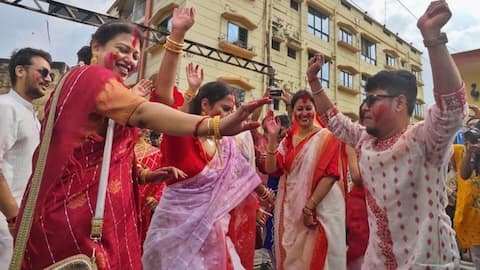Exploring key rituals that capture the spirit of Durga Puja
What's the story
Durga Puja is not only a grand celebration but also a deeply spiritual event that unites communities in honoring shakti, the divine feminine power. Beyond the elaborate pandals, the festival is brought to life by centuries-old rituals rich in symbolism. Let's explore the key Durga Puja rituals that invoke the goddess and embody the cultural and spiritual essence of the festival.
Invoking
Bodhon
The festival begins with bodhon, the ritual to invoke Goddess Durga into the idol. Devotees chant hymns and perform rituals, inviting her from her heavenly abode to Earth. Married women apply vermilion, don new sarees, and welcome the goddess with holy Ganges water, betel leaves, and betel nuts, symbolizing her arrival and the start of the festivities.
Holy bathing
Nabapatrika snan
Nabapatrika snan is a significant ritual involving the ceremonial bathing of the nabapatrika, or "nine plants," which represent the nine forms of Goddess Durga. The nine plants include banana, pomegranate, ash gourd, rice, turmeric, colocasia, arum, ashoka, and jayanti. Once tied together, they are bathed in the holy Ganges. The nabapatrika is then wrapped in a saree and placed alongside Lord Ganesha's idol.
Welcome
Shashthi puja
Shashthi puja, held on the sixth day, marks the formal welcome of the goddess with offerings like flowers, sweets, and fruits. The idol is adorned in beautiful sarees and jewelry, creating a lively scene. Devotees perform rituals to invoke her presence, offering prayers for blessings, as the main festivities begin, filling the atmosphere with excitement and devotion.
Triumph
Sandhi puja
Sandhi puja, a key ritual during Durga Puja, is performed at the transition between Ashtami and Navami to honor Goddess Durga's battle with the demon Mahishasura. The priest offers 108 lamps and chants sacred verses, symbolizing the victory of good over evil. This powerful ritual is considered the festival's most significant moment, attracting many devotees to witness its spiritual intensity.
Floral offering
Anjali
During Durga Puja, while priests perform rituals, devotees participate in pushpanjali (floral offering) on Saptami, Ashtami, and Navami. Held in the morning, the auspicious time is announced in advance. It's customary to fast until anjali is offered. Dressed in new clothes, devotees gather, holding flowers and bel leaves, repeating the priest's mantra before offering flowers to the goddess in three rounds.
Dance
Dhanuchi naach
Dhunuchi naach, one of the most exciting rituals of Durga Puja, takes place on Navami, the ninth day. Devotees hold clay pots filled with burning charcoal and dance to the rhythmic beats of the dhaak. Skilled participants balance the pots on their heads or grip them with their teeth. Once a male-dominated dance, it now includes women, adding to the festive spirit.
Immersion
Dashami
Dashami marks the conclusion of Durga Puja, as the goddess's idols are immersed in water, symbolizing her return to Mount Kailash. The immersion is accompanied by lively chants, songs, and dancing, creating a vibrant atmosphere. Devotees, filled with mixed emotions of joy and sorrow, bid farewell, hoping for her return next year. This ritual captures the essence of Durga Puja.
